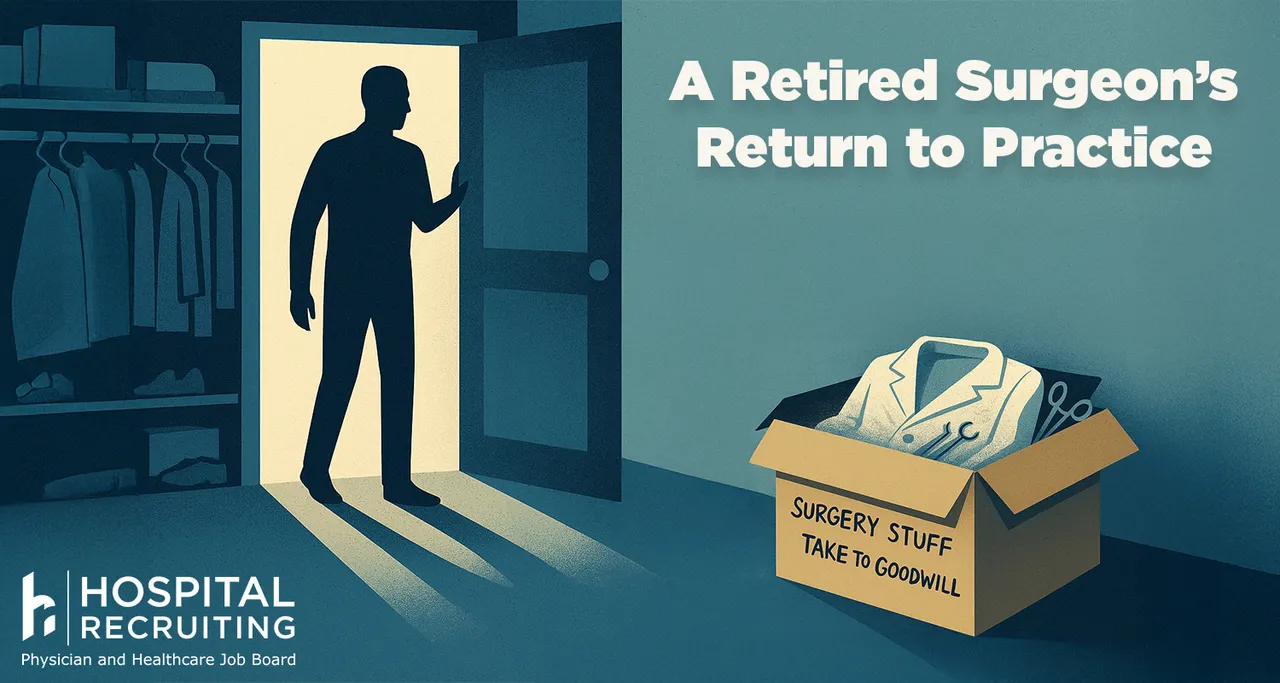Physician Reentry: A Retired Surgeon’s Return to Practice

In November 2001, after being retired from professional basketball for three years, the greatest basketball player in history, Michael Jordan, made his final comeback—not with the team that he led to a dynastic six NBA championships, but with the rebuilding Washington Wizards. It was a decision that required confidence, social support, and demonstration that his skills were still there.
Physician reentry refers to the process where a licensed physician, who has been inactive in clinical practice for a period of time, returns to active clinical practice. Not unlike Jordan, I experienced my own comeback of sorts in January 2024. That was when I decided to reenter clinical medicine and surgical practice after choosing to retire three years earlier.
Why I retired
After 28 years in medicine, I had reached an inflection point. I had achieved financial independence and was starting to become dismayed with the state of hospital employment. Long commutes, frequent ER call nights, EHR and “quality” requirements, pre-authorization challenges, and opioid prescribing restrictions led me to professional burnout. This was also 2020, at the height of COVID-19. The way we saw patients had drastically changed, and all elective surgeries were postponed indefinitely. For me, these were the final submissions that led me to “tap out” at the end of my hospital contract.
Retirement wasn’t a day at the beach
Although Michael Jordan initially worked on his golf game and his endorsements after his last championship with the Bulls, he still yearned to get back into the NBA. Therefore, a year and half into retirement, he accepted the position of President of Basketball Operations with the Washington Wizards. In this role, Jordan spent time evaluating draftees for the Wizards, managing the salary cap, and acting as a mentor to the newer generation of players. It was this hands-on role with the players that convinced Michael to come back as a player again to really show the younger guys how to be a professional. To ease his transition, he hired his old coach and friend, Doug Collins, to coach the Wizards for his comeback season.
When I decided to retire, I eagerly jumped back into activities such as cycling, swimming, and working out. I tackled the honey-do list and helped with walking our three dogs. However, I still did just enough CME to keep my medical license and board certification active, just in case. About a year into retirement, I decided to get back into part-time, non-clinical work by performing musculoskeletal Compensation & Pension exams for the Veterans Administration. In this role, I used my expertise in orthopedics to assist the VA in evaluating veterans claiming disability from service-connected orthopedic conditions. This opportunity allowed me to give back to the military community of which I was once a part. It also rekindled my enthusiasm for orthopedics and rejuvenated a desire to return to clinical medicine. With this renewed commitment, I contacted an old colleague who was the Orthopedic Chief at a VA Medical Center in the Southeast, asking him his opinion of me reentering clinical medicine. He responded by welcoming me into his Ortho department as a fully credentialed, locum tenens surgeon for one week each month.
The Return
Michael Jordan came back to immense fanfare. NBA fans eagerly wanted to see MJ play again. Because he lacked the same athleticism and reflexes he possessed in his prime, Jordan relied on his fundamentals, his discipline, and his experience to average over 20 points per game in his two comeback seasons. Sure, there were a few missed dunks, and the first season was limited to 60 games because of a knee injury. But, there were also 45- and 51-point outbursts and game-winning shots. Jordan showed that even in his forties, he could still compete at a high level against the NBA’s best at that time.
My own reentry into clinical medicine occurred more modestly. When you have done thousands of knee and shoulder arthroscopies as I had over my career, the fundamentals and muscle memory easily returned for me just like it had for Jordan. Sure, the reflexes were a little slower, and a few more passes of the needle might have been needed to get some stitches exactly right, but I eventually returned to the complex reconstructions and total joint arthroplasties that I did in my prime years. This old dog was even taught new tricks using the advanced arthroscopic implants and new total joint technology proliferating within orthopedic surgery.
Why the transition worked
Michael Jordan never really strayed very far from the NBA in retirement. By taking an executive position with the Washington Wizards, he was able to evaluate firsthand the next generation of basketball players coming into the NBA. By observing and participating in the Wizards’ practices, he could gauge where his basketball skills stood against current players. As a player with 13 seasons, 6 championships, and 5 Most Valuable Player awards on his resume, Jordan also possessed the experience and smarts to solve any game situation. And lastly, he had the support of a familiar coach leading his team. All of these factors enabled Jordan to seamlessly return to NBA arenas and show the fans that he was still a top-notch player.
Although I was not seeing patients or doing surgeries in early retirement, I maintained a few guardrails that helped my reentry. I kept my medical license active and did enough CME to re-certify with my orthopedic board. By seeing VA disability claimants, I preserved much of my basic diagnostic and evaluation skills in orthopedics. Along with the endorsement of my previous colleague, these factors convinced the VA credentialing committee to grant me full, unrestricted attending status upon my reentry. I have no doubt that the many years of teaching surgery skills to residents ingrained in me the motor movements of surgery that instinctively came back upon returning to the OR.
The Legacy remains untarnished
There would be no more championships for the returning Michael Jordan. The Washington Wizards did not even make the playoffs in either of his two years of playing. However, Jordan was chasing a different narrative. He was driven by a love for the game, the drive to compete, and the desire to impart lessons upon aspiring younger players. These were his comeback achievements.
For me, my reentry back to surgical practice was motivated by a love of orthopedics, the drive to take care of veterans, and the unfulfilled feeling that I still had something left to give. The transition back was pretty smooth. I found a health system that I felt comfortable working in. There were no quotas, promotions, or bonuses to strive for. My skills came back rather easily, and my complication rate was low. In fact, the past two years working again have been a blast. I am getting to the point where I am ready to hang up the labcoat again, but this time I am strolling out with a professional fulfillment that my previous years lacked.
Related Posts
